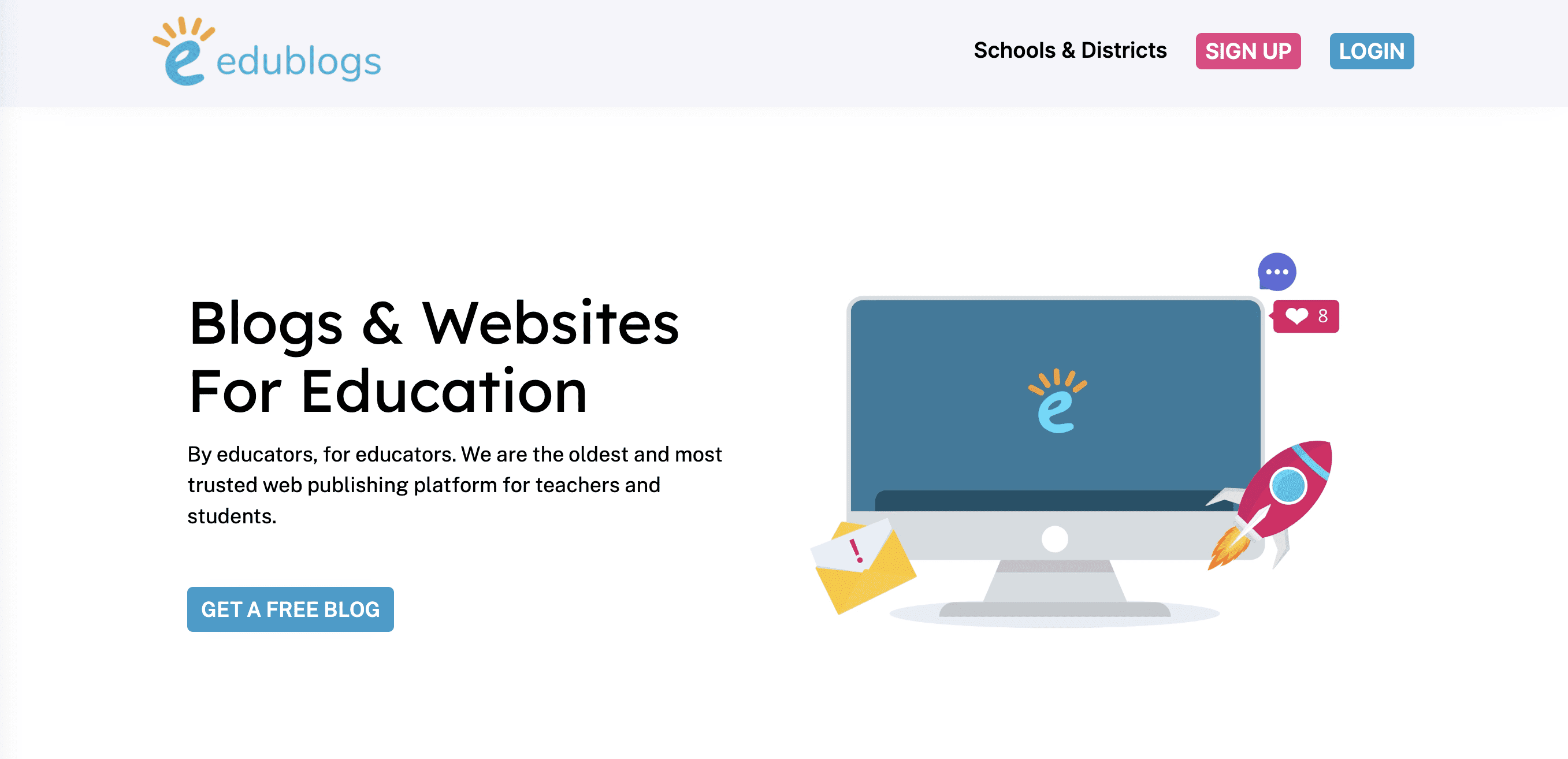How to Build a Simple Teacher Blog for an Organised Classroom

A teacher blog isn’t just for sharing ideas—it’s an essential tool for organising classroom resources, engaging students, and fostering collaboration. Whether you want to create a hub for lesson plans, encourage student writing, or improve parent communication, a well-structured blog can streamline your teaching life.
Once your teacher blog is set up, you’ll want engaging content ideas. Explore 10 blog ideas for students to encourage creativity and collaboration!
In this guide, we’ll walk you through how to build a teacher blog, from choosing a platform to managing student contributions effectively. By the end, you’ll have a fully functional classroom blog that saves time and enhances learning.
Step 1: Choose the Right Blogging Platform
Before setting up your teacher blog, you need to pick a platform that balances ease of use, customisation, and security. Here are the top choices for educators:
1. Edublogs (Best for Simplicity)
🟣 Edublogs is Built specifically for teachers and students
🟣 Includes privacy controls for safe student interaction
🟣 Simple, no-code setup with education-focused themes
2. WordPress (Best for Customisation & Growth)
🟣 WordPress gives full control over design and functionality
🟣 Works for both private teacher blogs and public classroom blogs
🟣 Requires a domain name and hosting plan (e.g., Bluehost, SiteGround)
3. Blogger (Best for Google Integration)
🟣 Blogger is free and easy to use with a Google account
🟣 Works well with Google Classroom & Drive
🟣 Limited design flexibility
Which One is Best?
- For beginners: Use Edublogs (quick and classroom-friendly)
- For flexibility: Use WordPress (best for long-term growth)
- For Google users: Use Blogger (seamless with Google tools)

Step 2: Set Up Your Teacher Blog in 5 Easy Steps
1. Pick a Blog Name & Domain
Your teacher blog should have a simple, memorable name. Try:
- Mrs. Smith’s Classroom Chronicles
- Creative Learning Hub
- Organised Teaching with Miss Lee
If using WordPress, register a custom domain (e.g., mrsleeteaches.com). If using Edublogs or Blogger, you’ll get a free subdomain.
2. Choose a Theme & Customise Layout
🟣 For an organised blog: Use clean, simple themes (e.g., Astra, Education Zone)
🟣 For student-friendly design: Pick a layout with easy navigation
🟣 For branding: Add a logo, class colours, and relevant images
3. Install Essential Plugins (WordPress Only)
To improve functionality, install these plugins:
- Yoast SEO – Helps rank your blog on Google
- WPForms – Allows students or parents to submit assignments or messages
- Elementor – Customise pages with drag-and-drop ease
4. Adjust Privacy & Student Access
🔒 Keep control over who can see your teacher’s blog:
- Public: Great for sharing lesson plans or class updates
- Private: Perfect for student blogging & discussions
- Password-Protected Pages: Hide certain content from the public
5. Write Your First Post!
Start with an introductory post explaining the blog’s purpose, such as:
- “Welcome to Our Class Blog! Here’s What to Expect”
- “How This Blog Will Help You Stay Organised”
- “Meet Your Teacher & Class Blogging Rules”

Step 3: Integrate Blogging into Your Classroom Routine
Setting up a teacher blog is just the beginning—next, you need to keep it active and useful without it becoming a time-consuming chore.
📝 How to Keep Your Blog Organised:
- Set a Blogging Schedule → Post once a week or bi-weekly
- Use Blog Categories → Organise posts (e.g., Lesson Plans, Homework, Student Work)
- Create a Resource Page → Store helpful links, worksheets, and FAQs
📅 Classroom Blog Ideas:
- Student of the Week Highlights
- Homework & Assignment Reminders
- Creative Writing Showcases
- Classroom News & Upcoming Events
Step 4: Manage Student Contributions Safely
Student engagement is key to a successful teacher blog, but you’ll want to ensure clear guidelines and privacy settings.
👩🏫 Guidelines for Student Blog Posts
🟣 Use first names only or initials
🟣 Keep content positive and constructive
🟣 Always proofread before posting
🟣 Give credit for images & research sources
🛠 Tools to Manage Student Contributions
📌 Google Docs – Draft and peer review posts before publishing
📌 Flip – Record student video reflections instead of writing
📌 Canva – Create blog graphics and digital storytelling elements
Step 5: Time-Saving Tips for Blogging Teachers
Running a teacher blog should feel helpful, not overwhelming. Here’s how to save time:
🟣 Use Pre-Made Blog Templates → Set up post formats for lesson plans, student work, or announcements
🟣 Schedule Posts in Advance → Write multiple posts and schedule them to publish weekly
🟣 Encourage Student Blogging Teams → Rotate students as editors, content creators, and designers
🟣 Automate Comments & Notifications → Use plugins like Akismet to filter spam comments

Final Thoughts: Why a Teacher Blog is Worth It
A well-organised teacher blog transforms your classroom into a connected, engaged, and structured learning environment. Whether you’re using it for lesson planning, student collaboration, or parent communication, the effort you put in will pay off in smoother classroom management and enriched learning experiences.
💡 Many teachers like myself, use blogs not just for student interaction but also as classroom organisers. For example, a teacher blog can act as a central hub where students access instructions, reference materials, and even link to their own project blogs. This makes classroom management easier while supporting independent learning.
Now that your blog is ready, it’s time to start posting! Get inspired with these 10 blog ideas for students designed to spark creative thinking in your classroom.
Are you ready to start? Choose a platform, set up your teacher blog, and begin simplifying your teaching life today! 🚀
FAQs
1. How can a teacher blog help with classroom organisation?
A teacher blog centralises lesson plans, student resources, and classroom updates, making it easier to manage materials and communication.
2. What is the best blogging platform for teachers?
Edublogs (easy setup), WordPress (flexibility), and Blogger (Google integration) are great choices.
3. How do I keep my teacher blog organised?
Use categories, templates, and a posting schedule to maintain clarity and consistency.
4. Can students contribute to a teacher’s blog?
Yes! Set guidelines for safe blogging, use private student accounts, and manage posts via Google Docs or Flip before publishing.
5. What privacy settings should I use for a classroom blog?
Choose between public, private, or password-protected pages, depending on your audience.

Your point of view caught my eye and was very interesting. Thanks. I have a question for you.
Your point of view caught my eye and was very interesting. Thanks. I have a question for you.
Thank you for your sharing. I am worried that I lack creative ideas. It is your article that makes me full of hope. Thank you. But, I have a question, can you help me?